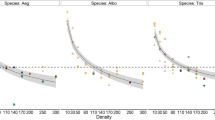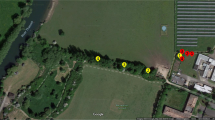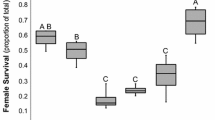Abstract
Processes that change with density are inherent in all populations, yet quantifying density dependence with empirical data remains a challenge. This is especially true for animals recruiting in patchy landscapes because heterogeneity in habitat quality in combination with habitat choice can obscure patterns expected from density dependence. Mosquitoes (Diptera: Culicidae) typically experience strong density dependence when larvae compete for food, however, effects vary across species and contexts. If populations experience intense intraspecific density-dependent mortality then overcompensation can occur, where the number of survivors declines at high densities producing complex endogenous dynamics. To seek generalizations about density dependence in a widespread species of Arctic mosquito, Aedes nigripes, we combined a laboratory experiment, field observations, and modeling approaches. We evaluated alternative formulations of discrete population models and compared best-performing models from our lab study to larval densities from ponds in western Greenland. Survivorship curves from the lab were the best fit by a Hassell model with compensating density dependence (equivalent to a Beverton-Holt model) where peak recruitment ranged from 8 to 80 mosquitoes per liter depending on resource supply. In contrast, our field data did not show a signal of strong density dependence, suggesting that other processes such as predation may lower realized densities in nature, and that expected patterns may be obscured because larval abundance covaries with resources (cryptic density dependence). Our study emphasizes the importance of covariation between the environment, habitat choice, and density dependence in understanding population dynamics across landscapes, and demonstrates the value of pairing lab and field studies.




Similar content being viewed by others
Data availability material
The datasets and the code used for statistical analyses in the current study are available from the corresponding author on reasonable request.
References
Abrams PA (2009) When does greater mortality increase population size? The long history and diverse mechanisms underlying the hydra effect. Ecol Lett 12:462–474. https://doi.org/10.1111/j.1461-0248.2009.01282.x
Abrams PA, Matsuda H (2005) The effect of adaptive change in the prey on the dynamics of an exploited predator populations. Can J Fish Aquat Sci 62:758–766. https://doi.org/10.1139/f05-051
Anazawa M (2019) Inequality in resource allocation and population dynamics models. R Soc Open Sci 6:1–11. https://doi.org/10.1098/rsos.182178
Barraquand F, Pinot A, Yoccoz NG, Bretagnolle V (2014) Overcompensation and phase effects in a cyclic common vole population: between first and second-order cycles. J Anim Ecol 83:1367–1378. https://doi.org/10.1111/1365-2656.12257
Beverton RJH, Holt SJ (1957) On the dynamics of exploited fish populations. H.M., London
Brannstrom A, Sumpter DJT (2005) The role of competition and clustering in population dynamics. Proc R Soc B Biol Sci 272:2065–2072. https://doi.org/10.1098/rspb.2005.3185
Breed GA, Don Bowen W, Leonard ML (2013) Behavioral signature of intraspecific competition and density dependence in colony-breeding marine predators. Ecol Evol 3:3838–3854. https://doi.org/10.1002/ece3.754
Briggs AA, Osenberg CW (2019) Spatial aggregation of aquatic habitats affects oviposition patterns in Aedes mosquitoes. Oecologia 190:835–845. https://doi.org/10.1007/s00442-019-04448-3
Carpenter SR (1983) Resource limitation of larval treehole mosquitoes subsisting on beech detritus. Ecology 64:219–223
Chesson P, Huntly N (1997) The roles of harsh and fluctuating conditions in the dynamics of ecological communities. Am Nat 150:519–553
Corbet PS, Danks HV (1973) Seasonal emergence and activity of mosquitos (Diptera: Culicidae) in a high-arctic locality. Can Entomol 105:837–872
Corbet PS, Downe AE (1966) Natural hosts of mosquitoes in Northern Ellesmere Island. J Arct Inst North Am 19:153–161
Cortez MH, Abrams PA (2016) Hydra effects in stable communities and their implications for system dynamics. Ecology 97:1135–1145
Culler LE, Ayres MP, Virginia RA (2015) In a warmer Arctic, mosquitoes avoid increased mortality from predators by growing faster. Proc R Soc B Biol Sci 282:1–9
Culler LE, Ayres MP, Virginia RA (2018) Spatial heterogeneity in the abundance and fecundity of Arctic mosquitoes. Ecosphere 9:1–11. https://doi.org/10.1002/ecs2.2345
Culler LE, Stendahl AM, DeSiervo MH, Bliska HM, Virginia RA, Ayres MP (2021) Emerging mosquitoes (Aedes nigripes) as a resource subsidy for wolf spiders (Pardosa glacialis) in western Greenland. Polar Biol. https://doi.org/10.1007/s00300-021-02875-8
Dahl C, Nielsen LT, Petersson E (2004) Mosquito larvae (Diptera: Culicidae) in snow-melt pools in a Swedish Lapland. J Vector Ecol 29:109–123
Dempster JP (1983) The natural control of populations of butterflies and moths. Biol Rev 58:461–481
DeSiervo MH, Ayres MP, Virginia RA, Culler LE (2020) Consumer–resource dynamics in Arctic ponds. Ecology. https://doi.org/10.1002/ecy.3135
Finger Higgens RA, Chipman JW, Lutz DA, Culler LE, Virginia RA, Ogden LA (2019) Changing lake dynamics indicate a drier Arctic in western Greenland. J Geophys Res Biogeosciences 124:870–883. https://doi.org/10.1029/2018JG004879
Gaston AJ, Hipfner JM, Campbell D (2002) Heat and mosquitoes cause breeding failures and adult mortality in an arctic-nesting seabird. Ibis (lond 1859) 144:185–191
Gaston KJ, Lawton JH (1987) A test of statistical techniques for detecting density dependence in sequential censuses of animal populations. Oecologia 74:404–410. https://doi.org/10.1007/BF00378937
Gimnig JE, Ombok M, Otieno S, Kaufman MG, Vulule JM, Walker ED (2002) Density-dependent development of Anopheles gambiae (Diptera : Culicidae) larvae in artificial habitats. J Med Entomol 39:162–172
Hanski I (1990) Density dependence, regulation and variability in animal populations. Philos Trans R Soc London Ser B Biol Sci 330:141–150. https://doi.org/10.1098/rstb.1990.0188
Hassell MP (1975) Density-dependence in single-species populations. J Anim Ecol 44:283–295. https://doi.org/10.2307/3863
Hassell MP (1987) Detecting regulation in patchily distributed animal populations. J Anim Ecol 56:705–713. https://doi.org/10.2307/5078
Hassell MP, Lawton JH, May RM (1976) Patterns of dynamical behaviour in single-species populations. J Anim Ecol 70:641–649
Holyoak M (1994) Identifying delayed density dependence in time-series data. Oikos 70:296–304. https://doi.org/10.2307/3545641
Joly K, Couriot O, Cameron MD, Gurarie E (2020) Behavioral, physiological, demographic and ecological impacts of hematophagous and endoparasitic insects on an arctic ungulate. Toxins (basel) 12:1–9. https://doi.org/10.3390/toxins12050334
Juliano SA (2007) Population dynamics. J Am Mosq Control Assoc 23:265–275
Juliano SA (2009) Species interactions among larval mosquitoes: Context dependency across habitat gradients. Annu Rev Entomol 54:37–56. https://doi.org/10.1146/annurev.ento.54.110807.090611.Species
Kraus JM, Vonesh JR (2012) Fluxes of terrestrial and aquatic carbon by emergent mosquitoes : a test of controls and implications for cross-ecosystem linkages. Oecologia 170:1111–1122
Leonard P, Juliano SA (1995) Effect of leaf litter and density on fitness and population performance of the hole mosquito Aedes triseriatus. Ecol Entomol 20:125–136
Livdahl TP (1982) Competition within and between hatching cohorts of a treehole mosquito. Ecology 63:1751–1760. https://doi.org/10.2307/1940117
Livdahl TP, Sugihara G (1984) Non-linear interactions of populations and the importance of estimating per capita rates of change. J Anim Ecol 53:573–580. https://doi.org/10.2307/4535
May RM, Conway GR, Hassell MP, Southwood TR (1974) Time delays, density dependence and single-species oscillations. J Anim Ecol 43:747–770. https://doi.org/10.2307/3535
McIntire KM, Juliano SA (2018) How can mortality increase population size? A test of two mechanistic hypotheses. Ecology 99:1660–1670. https://doi.org/10.1002/ecy.2375
Merritt RW, Dadd RH, Walker ED (1992) Feeding behavior, natural food, and nutritional relationships of larval mosquitoes. Annu Rev Entomol 37:349–376. https://doi.org/10.1146/annurev.en.37.010192.002025
Murdoch WW (1994) Population regulation in theory and practice. Ecology 75:271–287
Neale JT, Juliano SA (2019) Finding the sweet spot: what levels of larval mortality lead to compensation or overcompensation in adult production? Ecosphere 10:1–15
Neale JT, Juliano SA (2020) Predation yields greater population performance: what are the contributions of density- and trait- mediated effects? Ecol Entomol 46:56–65
Nicholson AJ (1957) The self-adjustment of populations to change. Cold Spring Harb Symp Quant Biol 22:153–173. https://doi.org/10.1101/sqb.1957.022.01.017
Nicholson AJ, Bailey VA (1935) The balance of animal populations—part I. Proc Zool Soc London 105:551–598. https://doi.org/10.1111/j.1096-3642.1935.tb01680.x
Péron G, Nicolai CA, Koons DN (2012) Demographic response to perturbations: the role of compensatory density dependence in a North American duck under variable harvest regulations and changing habitat. J Anim Ecol 81:960–969. https://doi.org/10.1111/j.1365-2656.2012.01980.x
Post E, Alley RB, Christensen TR et al (2019) The polar regions in a 2 C warmer world. Sci Adv 5:1–12. https://doi.org/10.1126/sciadv.aaw9883
Quinn TJ, Deriso RB (1999) Quantitative fish dynamics. Oxford University Press, New York, New York
R Core Team (2019) R: a language and environment for statistical computing. https://www.R-project.org/. Accessed 1 May 2019
Renshaw M, Service MW, Birley MH (1993) Density-dependent regulation of Aedes cantans (Diptera : Culicidae) in natural and artificial populations. Ecol Entomol 18:223–233
Ricker WE (1954) Stock and recruitment. J Fish Canada 11:559–623
Rose KA Jr, JHC, Winemiller K, et al (2001) Compensatory density dependence in fish populations : importance, controversy, understanding and prognosis. Fish Fisheries 2:293–327
Schmitt RJ, Holbrook SJ, Osenberg CW (1999) Quantifying the effects of multiple processes on local abundance: a cohort approach for open populations. Ecol Lett 2:294–303. https://doi.org/10.1046/j.1461-0248.1999.00086.x
Schröder A, van Leeuwen A, Cameron TC (2014) When less is more: Positive population-level effects of mortality. Trends Ecol Evol 29:614–624. https://doi.org/10.1016/j.tree.2014.08.006
Shima J, Osenberg CW (2003) Cryptic density dependence: Effects of covariation between density and site quality in reef fish. Ecology 84:46–52
Southwood TR, Murdie G, Yasuno M et al (1972) Studies on the life budget of Aedes aegypti in Wat Samphaya, Bangkok, Thailand. Bull World Health Organ 46:211–226
Stewart-Oaten A, Murdoch WW (1990) Temporal consequences of spatial density dependence. J Anim Ecol 59:1027–1045. https://doi.org/10.2307/5029
Strong DR (1986) Density-vague population change. Trends Ecol Evol 1:39–42
Stubbs M (1977) Density dependence in the life-cycles of animals and its importance in K and R strategies. J Anim Ecol 46:677–688. https://doi.org/10.2307/3837
Swenson JE, Sandegren F, Bjärvall A et al (1994) Size, trend, distribution and conservation of the brown bear Ursus arctos population in Sweden. Biol Conserv 70:9–17
Turchin P (1990) Rarity of density dependence or population regulation with lags? Nature 344:660–663. https://doi.org/10.1038/344660a0
Turchin P (2003) Complex population dynamics: a theoretical /empirical synthesis. Princeton University Press, Princeton, NJ
Urbanowicz C, Virginia RA, Irwin RE (2018) Pollen limitation and reproduction of three plant species across a temperature gradient in western Greenland. Arctic, Antarct Alp Res 50:1–12. https://doi.org/10.1080/15230430.2017.1414485
Vickery WL, Nudds TD (1991) Testing for density-dependent effects in sequential censuses. Oecologia 85:419–423. https://doi.org/10.1007/BF00320619
Vonesh JR, De la Cruz O (2002) Complex life cycles and density dependence: assessing the contribution of egg mortality to amphibian declines. Oecologia 133:325–333. https://doi.org/10.1007/s00442-002-1039-9
Walker ED, Merritt RW (1991) Behavior of larval Aedes triseriatus (Diptera: Culicidae). J Med Entomol 28:581–589
Washburn J (1995) Regulatory factors affecting larval mosquito populations in container and pool habitats: implications for biological control. J Am Mosq Control Assoc 11:279–283
Wilson J, Osenberg CW (2002) Experimental and observational patterns of density-dependent settlement and survival in the marine fish Gobiosoma. Oecologia 130:205–215. https://doi.org/10.1007/S004420100784
Wirta HK, Vesterinen EJ, Hambäck PA, Weingartner E, Rasmussen C, Reneerkens J, Schmidt NM, Gilg O, Roslin T (2015) Exposing the structure of an Arctic food web. Ecol Evol 5:3842–3856. https://doi.org/10.1002/ece3.1647
Witter LA, Johnson CJ, Croft B, Gunn A, Porier LM (2012) Gauging climate change effects at local scales: weather-based indices to monitor insect harassment in caribou. Ecol Appl 22:1838–1851. https://doi.org/10.1890/11-0569.1
Woiwod AP, Hanski I (1992) Patterns of density dependence in moths and aphids. J Anim Ecol 61:619–629. https://doi.org/10.2307/5617
Yee DA, Juliano SA (2006) Consequences of detritus type in an aquatic microsystem: effects on water quality, micro-organisms and the performance of the dominant consumer. Freshw Biol 51:448–459. https://doi.org/10.1111/j.1365-2427.2005.01504.x
Yee DA, Juliano SA (2012) Concurrent effects of resource pulse amount, type, and frequency on community and population properties of consumers in detritus-based systems. Oecologia 169:511–522. https://doi.org/10.1007/s00442-011-2209-4
Yee DA, Kaufman MG, Juliano SA (2007) The significance of ratios of detritus types and micro-organism productivity to competitive interactions between aquatic insect detritivores. J Anim Ecol 76:1105–1115. https://doi.org/10.1111/j.1365-2656.2007.01297.x
Acknowledgements
We thank Angela Spickard, Balt von Huene and Hanna Bliska for help with fieldwork, and Alex Stendahl, Rebecca Finger, and Francesca Governali for help with field and lab work. We thank the CH2MHill Polar Services team for logistical field support, and the managers of the Kangerlussuaq International Science Station (KISS), where we conducted lab studies. We thank Naalakkersuisut (the Government of Greenland) for permission to work in Kangerlussuaq, Greenland. Constructive feedback on the manuscript was provided by Ross Virginia, Mark McPeek, Steve Juliano, and two anonymous reviewers. We also thank Lauren Shoemaker for helpful feedback on the nonlinear model-fitting approach.
Funding
This study was supported by three National Science Foundation awards to LEC and MPA (#0801490, #1506155, #1748137). Additional funding was provided by the Dickey Center for International Understanding (McCullough fellowship to MHD).
Author information
Authors and Affiliations
Contributions
MHD conceived and designed the experiments, collected, and analyzed the data, and wrote the manuscript. LEC assisted in experimental design, collected data, and edited the manuscript. MPA assisted in project design, data analysis and edited the manuscript. All authors gave final approval for publication.
Corresponding author
Ethics declarations
Conflicts of interest
The authors declare no conflicts of interests.
Ethical approval
Ethics approval was not required for this study according to local legislation (Naalakkersuisut, the Government of Greenland).
Additional information
Communicated by Jill Lancaster.
Supplementary Information
Below is the link to the electronic supplementary material.
Rights and permissions
About this article
Cite this article
DeSiervo, M.H., Ayres, M.P. & Culler, L.E. Quantifying the nature and strength of intraspecific density dependence in Arctic mosquitoes. Oecologia 196, 1061–1072 (2021). https://doi.org/10.1007/s00442-021-04998-5
Received:
Accepted:
Published:
Issue Date:
DOI: https://doi.org/10.1007/s00442-021-04998-5




